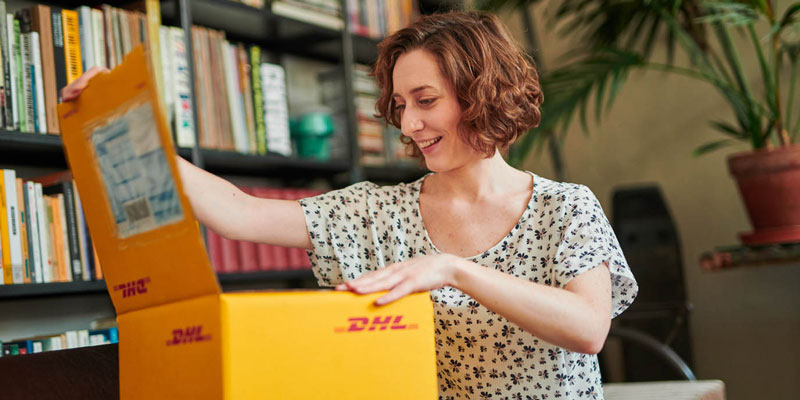Grow your business with the Discover newsletter
Logistics advice & insights straight to your inbox
Subscribe now
As Coronavirus spreads around the world, employees in more and more companies are working from home. Areas are quarantined, many shops remain closed. People are currently changing their everyday lives, but not their consumer habits. The difficulties associated with traditional retail together with unprecedented digital and mobile media usage offer enormous opportunities for online shops.
Whether it is a yoga mat, a new book, supplies of printer cartridges for home schooling for the kids or a keyboard so that you can work from home ... Your customer wants to be sure that the delivery takes place when he or she orders.
The fact that customers are now increasingly wondering whether delivery is taking place at all is not surprising.
Online buyers who ask these questions and do not get a clear answer will postpone their purchase or place their order with another online shop. DHL Express has put together 8 top tips for your online shop to help you determine how and where you can gain your customers' trust in the customer journey.

Make sure it is clear that you accept, process and send orders despite COVID-19 on the homepage. Many online shops have an info bar for special marketing messages, e.g. 'Free shipping from €100', 'Customer service from 7:00 a.m. to 7:00 p.m.', '100 day right of return'.
Use this bar for any communication around COVID-19 by adding copy along the lines of 'We are still there for you!', 'Shipping despite COVID-19' or 'Safe handling with protective masks and gloves'.
If your online shop does not have a banner like that, use the footer to communicate your offer. If you want to make the most of the communication, you can choose to use an image in the header or a slider image on the homepage.
Often, visitors land straight on a category page or a product detail page. Again, explain that orders are processed as usual. Try copy on the product image, or an extra message near the buy button. Use the area where you communicate the delivery time effectively by adding a short clarification like 'Normal delivery despite COVID-19'.
Use the opportunity to communicate in the shopping cart that you are working with a shipping partner who delivers promptly and in permitted areas. If your shipping partner expects delays, please also report them.
Many shipping partners communicate the current delivery times and delivery areas on their homepage and / or via a newsletter. Pay attention to this information and update it in your online shop.
A Google search often precedes a visit to your online shop. If you adjust your meta description now, online customers can already see that the online shop can deliver during their initial search. This can be crucial for generating traffic in the online shop, since the search result already answers the question that your customer most likely has. For example, add 'Shipping despite COVID-19' to your meta description.

You can easily find out what questions your customers have about COVID-19 by looking at their emails and analyzing calls to customer support. Record the frequently asked questions and formulate an answer, which you collect on an FAQ page. Link any communication you make in your online shop regarding COVID-19 (banner, info bar, shopping cart, etc.) to this FAQ page.
Make sure that your call center is up to date and that the message they are giving matches what you are communicating in your online shop. Avoid confusion with contradictory statements. This damages trust - the opposite of what you want to do!
As soon as the online shop and call center are up to date, a newsletter is a good way to let your existing customers know what’s happening. For example, refer to the FAQs, show pictures of how warehouse staff work, mention testimonials from customers who enjoyed good service, share an evaluation of your current runtime or successful delivery rate, etc.
Whether via Instagram with a picture from the warehouse, via Facebook with a video from the call center answering customer questions, or via LinkedIn, where you as the managing director highlight the teamwork and emphasize customer satisfaction: being visible creates trust - exactly the right thing for your customers at this time!
Use these 8 valuable tips from DHL Express. They can be a successful strategy if you want to strengthen existing customer relationships, build new ones and make a quick return to business as usual after the restrictions.
Strengthen the trust of your customers in your online store with clear communication.
Against the background of the worldwide COVID -9 outbreak, the business activities of the Deutsche Post DHL Group are constantly being adjusted in order to mitigate possible effects.
As a global company, epidemic and pandemic risk scenarios are an integral part of the Group's ongoing risk planning. The Group follows an all-encompassing management process that enables our business units to ensure the highest level of service to our customers, even during emergency situations.
DHL is ready to take operational measures if DHL locations are specifically affected with the aim both of limiting the consequences for service provision and protecting other parts of our company.
DHL is continuously monitoring the situation and is taking all measures necessary to protect employees, customers and partners as well as ensuring that our services continue to function as smoothly as possible.
The health of our employees, customers and partners always comes first.
Read the full explanation: here